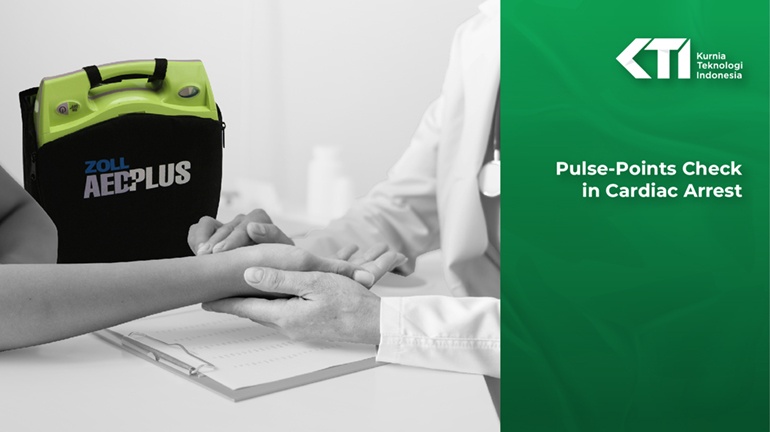Pulse Points Check in Cardiac Arrest
Cardiac arrest is a life-threatening emergency where the heart suddenly stops beating, cutting off oxygen-rich blood to vital organs like the brain. Without quick action, it can lead to permanent brain damage or death. That’s where Cardio-Pulmonary Resuscitation (CPR) comes in as a lifesaving technique that can restore blood flow to keep organs alive until professional help arrives. But to perform CPR effectively, you need to know about pulse points and how to locate them. In this article, we’ll explore what pulse points are, where they’re located and how crucial they are during CPR.
What Are Pulse Points?
Pulse points are specific areas on the body where you can feel the rhythmic beating of your heart as it pumps blood through your arteries. These points are usually where arteries lie close to the skin, making them easy to locate.
Understanding what pulse points are and how to use them is essential, especially in emergencies like cardiac arrest. Checking a pulse helps determine whether CPR is needed and ensures chest compressions are effective during resuscitation efforts.
Common Pulse Points in the Human Body
There are several pulse points in the body, each serving as a valuable tool for monitoring blood flow. Let’s take a closer look at the key pulse points and where to find them:
- Temporal Pulse Point
The temporal pulse point is located on the side of the head, in front of the tragus, which is the small cartilage near the ear. This pulse can be used to check circulation in the head, particularly in infants or in specific medical scenarios. - Radial Pulse Point
The radial pulse point is found on the wrist, on the thumb side of the forearm. To locate it, place two fingers just below the base of the thumb. This pulse is often checked in conscious individuals because it is easy to access and commonly used for monitoring heart rate in daily life. - Carotid Pulse Point
The carotid pulse point, located on either side of the neck just below the jawline, is one of the most critical pulse points, especially during CPR. It is the preferred point for checking a pulse in unconscious or unresponsive adults because it is easy to locate and provides a reliable indication of blood flow to the brain. - Brachial Pulse Point
The brachial pulse point can be found inside the arm, near the elbow crease. This pulse is primarily used for infants during CPR, as it is easier to access and monitor compared to other pulse points in small children. - Femoral Pulse Point
The femoral pulse point is located in the groin area, where the leg meets the abdomen. This pulse is often checked in emergencies when other pulse points are difficult to locate, such as in cases of severe trauma or shock. - Popliteal Pulse Point
The popliteal pulse point is found at the back of the knee, in the crease. It is used to assess blood flow to the lower legs and is particularly useful in medical evaluations involving circulation to the legs. - Posterior Tibial Pulse Point
The posterior tibial pulse point lies behind the bony bump on the inside of the ankle, known as the medial malleolus. This pulse is checked to assess circulation in the feet and lower legs. - Pedal Pulse Point
Finally, the pedal pulse point is located on the top of the foot, just behind the ankle. This pulse is important for monitoring blood flow to the lower limbs and can help identify conditions like poor circulation or blockages in the arteries.
Why Pulse Points Matter During CPR
When performing CPR, checking the pulse is crucial to assess whether the heart is pumping effectively. The carotid pulse point is the most reliable for adults because it’s easy to locate and provides a strong indication of blood flow to the brain.
Here’s how pulse points guide rescuers during CPR:
- Before CPR: If no pulse is detected at the carotid artery, begin chest compressions immediately.
- During CPR: Pulse checks help ensure that compressions are restoring blood flow effectively.
- After CPR: A returning pulse indicates that circulation has been restored.
How to Check for a Pulse During CPR
If you’re performing CPR on an unconscious adult, follow these steps to check for a pulse at the carotid pulse point:
- Locate the Pulse Point: Place two fingers gently on the side of the neck, below the jawline.
- Apply Gentle Pressure: Avoid pressing too hard, as this may block the artery.
- Count the Beats: Check for a pulse for up to 10 seconds.
- Take Action: If there’s no pulse, continue chest compressions at a rate of 100–120 per minute.
Performing CPR: Step-by-Step
When someone’s pulse is absent, here’s how to deliver effective CPR:
- Start Chest Compressions: Push hard and fast at the center of the chest (5–6 cm deep) at a rate of 100–120 compressions per minute.
- Give Rescue Breaths (for professionals): After 30 compressions, provide 2 rescue breaths by tilting the head back and lifting the chin.
- Use AED: Locate the nearest AED, turn it on, and follow the voice prompts. You will likely be given a set of instructions: 1) to stay away as the AED analyzes heart rhythm, 2) continue CPR, 3) push the shock button.
- Cycle Until Help Arrives: Alternate between compressions and breaths until professional help takes over.
For lay rescuers, hands-only CPR—chest compressions without rescue breaths—is recommended.
Understanding and locating pulse points isn’t just about medical knowledge—it’s about saving lives. what pulse points are, be it carotid or radial pulse points, and how to use them during emergencies, you can make a real difference in life-threatening situations like cardiac arrest. Visit our website at kurniateknologi.com and get your AEDs ready for cardiac arrest.

